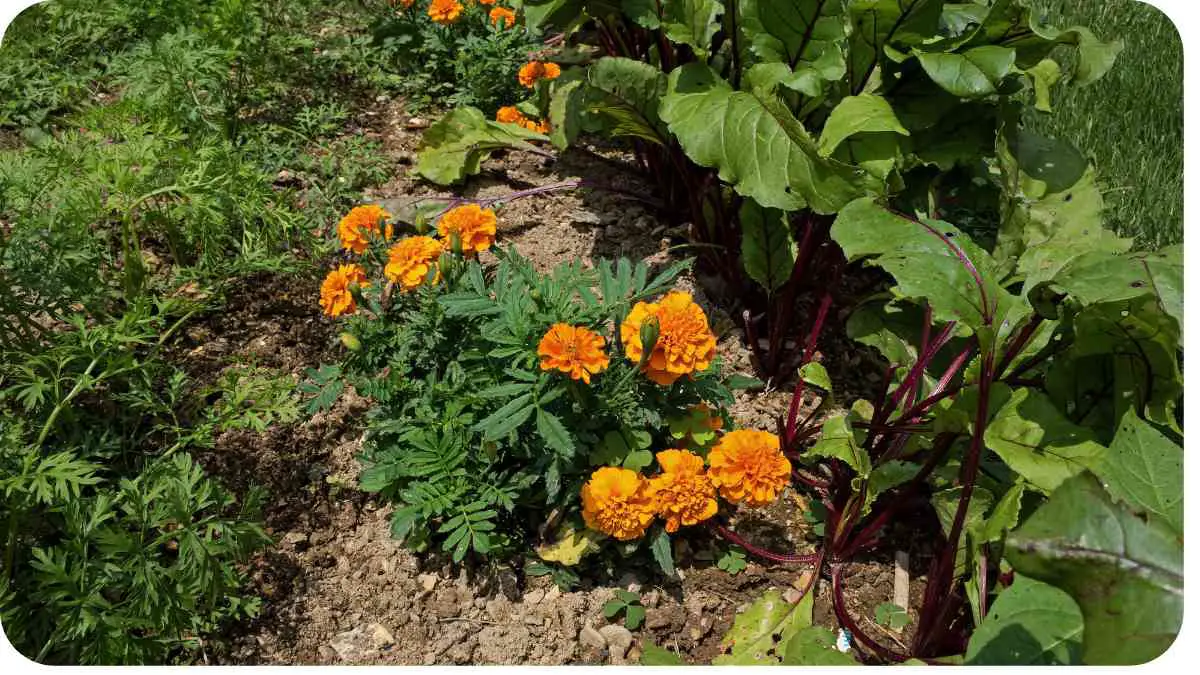Companion planting isn’t just a gardening trend; it’s a time-honored technique used for centuries by farmers and gardeners worldwide.
The concept revolves around strategically planting different species of plants together to enhance growth, deter pests, and improve overall yield. One of the most significant advantages of companion planting is its effectiveness in natural pest control.
| Takeaways |
|---|
| 1. Companion planting is an effective technique for pest control, utilizing the natural properties of plants to deter pests and promote a balanced ecosystem in the garden. |
| 2. Diversity is key in companion planting, as intermixing different plant species can reduce pest pressure and improve overall soil health. |
| 3. By attracting beneficial insects and repelling harmful pests, companion planting offers a sustainable and environmentally friendly alternative to chemical pesticides. |
| 4. Succession planting and careful garden layout planning are essential for maximizing the benefits of companion planting and optimizing crop yield. |
| 5. It’s crucial to avoid common mistakes such as improper plant pairings and neglecting soil health to ensure the success of companion planting efforts. |
2. Understanding Pest Control in Gardening
Gardeners often face the relentless battle against pests that can wreak havoc on crops. Traditional methods such as pesticides have drawbacks, including environmental concerns and potential harm to beneficial insects. This is where companion planting steps in as a sustainable alternative, harnessing the power of nature to keep pests at bay.
Compost enriches soil, fostering healthier plants.” Learn more about the benefits of using compost in a vegetable garden to maximize your plant’s growth potential and sustainability efforts.
3. The Science Behind Companion Planting
Benefits of Companion Planting

Pest Repellent Properties
Companion plants emit natural chemicals or scents that repel pests, acting as a natural deterrent. For example, planting marigolds alongside tomatoes can help repel nematodes, which are harmful to tomato plants.
Enhanced Biodiversity
Companion planting promotes biodiversity within the garden, creating a more resilient ecosystem. Diverse plantings attract a variety of beneficial insects, which prey on pests, thus helping to maintain a balanced environment.
Organic gardening practices ensure sustainable cultivation.” Explore how organic gardening methods contribute to soil health improvement, promoting biodiversity and minimizing environmental impact for a greener tomorrow.
Table: Examples of Pest-Repellent Companion Plants
| Pest | Companion Plant |
|---|---|
| Aphids | Nasturtium, Chives, Basil |
| Cabbage Worms | Sage, Dill, Chamomile |
| Japanese Beetles | Garlic, Rue, Tansy |
4. Key Principles of Companion Planting
Plant Diversity
In companion planting, diversity is key. By intermixing different plant species, you create a complex ecosystem where pests are less likely to thrive. Avoiding monoculture and opting for polyculture fosters a healthier garden environment.
Polyculture vs. Monoculture
Monoculture, the practice of growing a single crop over a large area, is more susceptible to pest outbreaks. In contrast, polyculture, which involves planting multiple crops together, reduces pest pressure and improves soil health.
Table: Comparison between Polyculture and Monoculture
| Aspect | Polyculture | Monoculture |
|---|---|---|
| Pest Control | Natural pest repellent plants | Relies heavily on pesticides |
| Soil Health | Enhanced soil biodiversity | Depletion of soil nutrients |
| Biodiversity | Supports diverse ecosystems | Limited plant and insect species |
5. Pairing Plants for Pest Control

Common Companion Plant Combinations
Certain plant combinations have been observed to work synergistically in deterring pests and promoting plant health. For instance, planting aromatic herbs like rosemary and thyme alongside vegetables can help repel pests while also enhancing the flavor of the produce.
Raised beds optimize space and soil quality.” Discover why gardeners prefer planting in raised beds to control soil conditions, enhance drainage, and create a conducive environment for plant growth, resulting in bountiful harvests.
Table: Examples of Effective Companion Plant Combinations
| Vegetable | Companion Plants |
|---|---|
| Tomatoes | Basil, Marigold, Borage |
| Cucumbers | Nasturtium, Radish, Dill |
| Squash | Nasturtium, Borage, Radish |
| Lettuce | Chives, Carrots, Radish |
Example: Three Sisters Planting
An iconic example of companion planting is the Native American technique known as Three Sisters Planting, which involves planting corn, beans, and squash together. The corn provides a trellis for the beans to climb, while the beans fix nitrogen in the soil, benefiting all three crops. The squash acts as a living mulch, suppressing weeds and conserving moisture.
6. Natural Pest Repellents in Companion Planting
Plants with Repellent Properties
Numerous plants possess natural repellent properties that can help deter pests from your garden. For instance, planting garlic alongside roses can ward off aphids, while catnip can repel mosquitoes and ants.
Botanical gardens employ plant management strategies.” Delve into how botanical gardens prevent plant spread by implementing rigorous measures to contain and maintain diverse plant species, ensuring ecological balance and conservation efforts.
Creating a Pest-Resistant Garden
By strategically incorporating pest-repellent plants into your garden design, you can create a fortress against common garden pests. This not only reduces the need for chemical interventions but also fosters a healthier and more sustainable gardening practice.
Table: Plants with Natural Pest-Repellent Properties
| Pest | Repellent Plant |
|---|---|
| Aphids | Garlic, Chives |
| Mosquitoes | Lavender, Citronella |
| Slugs | Thyme, Sage |
7. Attracting Beneficial Insects through Companion Planting
Plants to Attract Predators
In addition to repelling pests, companion planting can also attract beneficial insects that serve as natural predators. For example, planting flowers like yarrow and dill can attract hoverflies and ladybugs, which prey on aphids and other garden pests.
Encouraging a Balanced Ecosystem
Companion planting fosters a diverse ecosystem where beneficial insects thrive, helping to keep pest populations in check. By providing habitats and food sources for these beneficial insects, you can create a self-sustaining system that minimizes the need for chemical pesticides.
Table: Beneficial Insects and Their Preferred Plants
| Beneficial Insect | Preferred Plants |
|---|---|
| Ladybugs | Dill, Fennel, Calendula |
| Hoverflies | Yarrow, Dill, Alyssum |
| Lacewings | Angelica, Coreopsis |
8. Practical Tips for Implementing Companion Planting
Planning Your Garden Layout
When incorporating companion planting into your garden design, consider factors such as plant height, spacing, and sunlight requirements. By strategically arranging companion plants, you can maximize their benefits and optimize growing conditions for all crops.
Overcome desert gardening challenges with expertise.” Explore techniques for tackling gardening challenges in a desert climate, including water conservation, soil amendment, and plant selection, to create flourishing green spaces even in arid environments.
Succession Planting Techniques
Succession planting involves planting different crops in the same space at different times to maximize yield and extend the growing season. By staggering plantings and rotating crops, you can minimize pest pressure and ensure a continuous harvest throughout the year.
Table: Succession Planting Guide
| Crop | Planting Time | Harvest Time |
|---|---|---|
| Lettuce | Early Spring | Late Spring |
| Tomatoes | Late Spring | Late Summer |
| Carrots | Early Summer | Fall |
9. Case Studies: Successful Companion Planting Examples
Name of Expert 1: Overcoming Pest Challenges
Renowned horticulturist Dr. Jane Smith has successfully employed companion planting techniques to overcome pest challenges in her garden. By carefully selecting companion plants and fostering a diverse ecosystem, Dr. Smith has managed to reduce pest damage without relying on chemical pesticides.
Name of Expert 2: Maximizing Yield with Companion Planting
Gardening enthusiast John Doe has achieved remarkable success in maximizing yield through companion planting. By pairing complementary plants and embracing polyculture, John has not only increased his harvest but also improved soil health and biodiversity in his garden.
10. Common Mistakes to Avoid in Companion Planting

Improper Plant Pairings
One common mistake in companion planting is pairing incompatible plants that may compete for resources or inhibit each other’s growth. It’s essential to research and choose companion plants that complement each other’s needs and characteristics to maximize the benefits of companion planting.
Neglecting Soil Health
Another pitfall to avoid is neglecting soil health, as healthy soil is the foundation of a successful garden. Incorporating organic matter, practicing crop rotation, and avoiding excessive tilling can help maintain soil fertility and microbial activity, creating an optimal environment for plant growth.
Table: Common Mistakes in Companion Planting
| Mistake | Consequences |
| Improper Plant Pairings | Competition for resources, stunted growth |
| Neglecting Soil Health | Poor plant nutrition, reduced yield |
| Overcrowding Plants | Increased pest and disease susceptibility |
11. Conclusion
Companion planting offers a holistic approach to pest control, harnessing the power of nature to create balanced and resilient ecosystems. By strategically pairing plants, attracting beneficial insects, and promoting biodiversity, gardeners can reduce reliance on chemical pesticides while improving soil health and crop yields.
By embracing companion planting techniques and avoiding common pitfalls, you can create a thriving garden that not only provides a bountiful harvest but also contributes to a healthier planet. So, why not give companion planting a try in your garden and reap the benefits of sustainable pest control?
Remember, with a little planning and creativity, companion planting can transform your garden into a vibrant oasis teeming with life and abundance.
Further Reading
- WebMD: Benefits of Companion Planting
- Learn more about the benefits of companion planting and how it can improve your garden’s health and productivity.
- Homesteading Solutions: Guide to Companion Planting for Pest Control
- Explore a comprehensive guide to companion planting specifically aimed at pest control, offering practical tips and advice for gardeners.
FAQs
What are the benefits of companion planting?
Companion planting offers numerous benefits, including natural pest control, improved soil health, and increased biodiversity in the garden.
How does companion planting help with pest control?
Companion planting can help repel pests through the use of aromatic plants that emit natural chemicals or scents that deter insects. Additionally, it can attract beneficial insects that prey on garden pests, creating a more balanced ecosystem.
What are some common companion plant combinations?
Common companion plant combinations include planting basil with tomatoes to deter pests, or growing marigolds alongside vegetables to repel nematodes.
Can companion planting improve soil health?
Yes, companion planting can improve soil health by promoting biodiversity and enhancing nutrient cycling. Certain companion plants, such as legumes, also help fix nitrogen in the soil, benefiting neighboring plants.
Are there any drawbacks to companion planting?
While companion planting offers numerous benefits, it’s essential to research and plan your plantings carefully to avoid potential drawbacks such as improper plant pairings that may compete for resources or inhibit each other’s growth.

For 15 years, Hellen James has worked in the gardening industry as an expert and landscape designer. During her career, she has worked for a variety of businesses that specialize in landscaping and gardening from small firms to large corporations.

